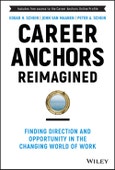In the newly revised edition of Career Anchors: Finding Stability and Opportunity in the Changing Nature of Work, a team of world-renowned management and culture experts delivers a uniquely insightful exploration of your own career values and work relationships as they relate to your past and future choices. This easy-to-use workbook in combination with an online self-assessment offers critical and accessible self-diagnostic exercises along with information about the changing career scene and new descriptions of the eight career anchor categories.
This book will help you: - Explore how your work choices now relate to your family and self-development - Explore how the rapidly changing world of work and business emphasizes globalization, competition, technology, organizational instability, uncertainty, and shifting values - Engage in a powerful relationship mapping process that helps you to consider how your work and career choices now interact with your relationships with family, friends, and community - Review the career anchor values and examine how these values have changed, so you can make better choices of what, when, where, and how to work as you look ahead
This newest edition of Career Anchors is a can’t-miss resource written to help you analyze, assess, and understand the past, present, and future of your own career. It belongs in the libraries of early-career - as well as established - professionals looking to take back control over their work trajectories.
Table of Contents
Acknowledgments ix
Preface xi
Introduction: Plan for This Book xvii
Chapter 1 Reflections on the Changing Workplace 1
Chapter 2 Building a Relationship Map 11
Chapter 3 The Changing Nature of the External and Internal Career 33
Chapter 4 The Eight Career Anchor Categories 43
Chapter 5 The Career Interview 65
Chapter 6 Career Anchors Assessment 73
Chapter 7 What’s Next? Growth Intentions 81
Chapter 8 Five Career Anchors Stories 87
Chapter 9 Conclusion 121
Appendix: Career Anchors and Career- Oriented Personality Assessments 127
Research Notes and References 139
About the Authors 145
Index 149








